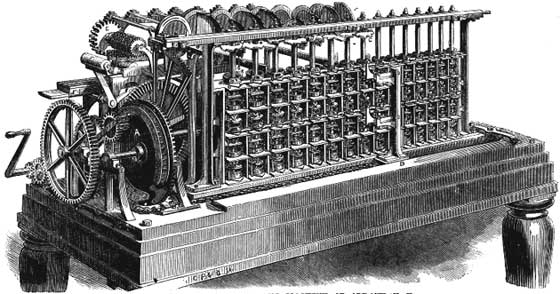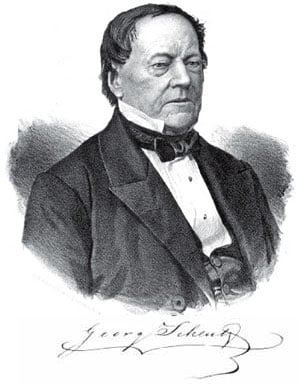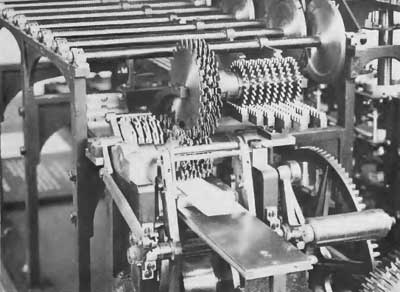Charles Babbage is widely recognized for inventing the first mechanical computer, the Difference Engine, in 1821. However, he never managed to build any of his many designs. Pehr-Georg Scheutz, a Swedish lawyer, translator, and inventor, and his son Edvard created the first operational and commercially viable Difference Engine in 1843. Amazingly, he had no background in mathematics or engineering. What’s more, he managed to improve upon Babbage’s concept by adding a printing mechanism to the design.
2 Facts about Pehr-Georg and Edvard Scheutz’s Difference Engine

- The Difference Engine of Pehr and Georg was an extended, smaller, and better version of Charles Babbage’s Difference Engine.
- While Babbage’s engine cost 15,000 pounds in 1829 “and was yet incomplete,” Scheutz stated that he could build a machine for 20000 riksdaler banco (about 1,638 pounds) in one to two years.
Difference Engine: History
On September 23, 1785, Per Georg Scheutz was born in Jonkoping, Sweden. Pehr-Georg Scheutz was born on September 23, 1785, in Jönköping, Sweden. Fredrik Christian Ludvig Schuetz, his father, was born in Copenhagen, Denmark, to German parents. He managed the famed inn and wine merchant’s company Fortuna in Jönköping with his wife, Johanna Christina Berg. Aside from the inn, Fredrik Schieutz was in charge of supplying refreshments to visitors at Medevi Spring, the country’s most famous spa at the time. Georg Scheutz, his parents’ only son, grew up in this exciting, cosmopolitan location at the southern end of Lake Vättern.
Quick Facts
- Created
- 1853
- Creator (person)
- Pehr-Georg, Edvard Scheutz.
- Original Use
- Calculate and print multiplication, division, and exponentiation in a logarithmic table.
- Cost
- N/A
Pehr-Georg by profession, was a lawyer, translator, and inventor from Sweden. Pehr-Georg Scheutz was married only once, to Anna Margaretha Schaumann. Anna, however, died of breast fever after giving birth on March 16, 1823. Scheutz and Anna had one child together, Edvard. Unfortunately, her second child died just one day after delivery.
Pehr-Georg Scheutz is best known for creating the Difference Engine, the first operational and commercially accessible Difference Engine. The Difference Engine was first proposed in 1837, but he did not complete it until 1843. The engine was made feasible owing to a significant gift by his son, Edvard, who was 22 years old at the time. Scheutz also designed the first whole printing calculator structure.

With his son Edvard Scheutz, he created a mechanism that could generate logarithmic tables, or it can be said that it was an extended and better version of Charles Babbage’s Difference Engine.
After reading a description of Babbage’s machine, after many experimental versions, he chose to create a Difference Engine in 1834. Unfortunately, even though he wasn’t a mathematician (like Babbage), he wasn’t an engineer, didn’t have much money, and lived in a nation far behind England in terms of technology. Nevertheless, he was able to do this. He (together with his son Edvard) constructed the world’s first working Difference Engine and printed calculating machine.
His son Edward suggested building a functioning model in metal in 1837, and in 1840 he completed the calculating section, which was capable of computing series with five-digit numbers and first-order differences and was subsequently expanded to third-order differences (1842). The model was finished in 1843 when Edvard added the printing section.
Construction of the bigger and better (15-digit numerals and fourth-order differences) machine began in 1851 with government funding and was completed in 1853. The engine was first shown at the World’s Fair in Paris in 1855 and subsequently sold to the Albany, New York-based Dudley Observatory in 1856. It was the first printing calculator to be marketed, and it was delivered in 1857. The British government ordered the next Scheutz’s difference machine in 1857, which was completed in 1859. It was built the same way as the last one and weighed around 10 cwt (1,100 lb.; 510 kg).
Difference Engine: How It Worked
After becoming more familiar with computational techniques and Babbage’s difference engine development, Scheutz produced several temporary models in wood, pasteboard, and wire at the beginning of 1837, which looked to prove the point. Then, in the summer of the same year, his son Edvard, a student at Stockholm’s Technological Institute, requested and received permission from his father to expand on a basic model of a different engine and create a metal version. Edvard had made so much progress with his work by the end of the summer that it looked utterly plausible to build a complete engine.
The overall measurements of the machine are: 56 cm x 170 cm x 58 cm.
All the units and movable parts in the machine were operated by hand by means of a crank. The force applied was transmitted by a system of gears to the cams, arms, and racks that operated the calculating unit. Beneath this were two carriages (one of them on wheels), which ran along rails, that were suitably curved to give the five vertical axles their up and down movements. The printing table in the printing unit was acted upon by a crank mechanism.
The calculation of a table was carried out in four stages:
- The start values of the table in question were calculated manually.
- The number wheels in the calculating unit were set at the start values with the help of a special tool.
- A piece of matrix material, wax, pasteboard, or lead, was fastened to the slide on the printing table. Then the slide was pushed in until the feeding hooks reached the first notch of the ratchet. The numerator was set at zero.
- The handle of the engine was cranked and after every sixth revolution, a result was printed.
The tabular values and differences were represented by the number of toothed wheels arranged horizontally in a 15-by-five array. The top row of 15 figures represented the tabular values; the second row, the first differences; the third row, the second differences; the fourth row, the third; and the fifth row, the constant fourth differences. At the outset of a computation, the number wheels were set manually. Each wheel had an adding mechanism, consisting of a “catch-and-trap” combination. There is an upward catch, attached to the upper part of the wheel, the corresponding trap to the central axis surrounded by that wheel, at a point approximately midway between it and the wheel above it. As the axes rotated, the traps revolved within the calculating wheels. Each trap had an arm that touched the catch of the wheel below it as the trap revolved.
Depending on the direction of this revolution, it either pressed down a portion of the catch and passed it freely, or was caught by it and raised. When the trap was raised, it engaged the number wheel above it, thereby turning it. A related stud and lever mechanism provided for carrying as the upper wheel passed from nine to zero (or five to zero, in the case of the “sexial” wheels. A small stud between these two digits pushed against a lever when a wheel passed from nine to zero. This lever extended to the left in front of the preceding wheel. The carrying action was prompted by a moving upright “pillar.” If the stud had pressed against the lever, this then came into contact with the pillar, causing a pivot arm on that pillar to engage the wheel behind the lever and to move it forward one unit, thus effecting the carry.
Difference Engine: Historical Significance
When Scheutz began translating several chapters from Charles Babbage’s prevalent book Economy of Machinery and Manufactures for his Journal för Manufakturer och Hushllning in 1832, he first learned about Charles Babbage and his machine. Scheutz also learned how to compute mathematical tables using the “method of differences” from this book.
Scheutz discovered a more detailed discussion of Babbage’s machine in the July 1834 issue of the magazine Edinburgh Review, in which the author of the article “Babbage’s calculating engine,” the Irish communicator of science Dionysius Lardner (1793-1859), reviewed a set of seven publications about the machine. Those publications ranged from Babbage’s accounts of 1822, and 1823-1829 reports by a committee of the Rochdale Society. In addition, Lardner sketched several central tables produced over the previous fifty years, using them to illustrate the difficulty and importance of producing large quantities of error-free copies. It also described the machine’s operation and Babbage’s concept of mechanical notation in a relatively non-technical manner.

Edvard’s progress pleased his father immensely. On October 3, 1837, he wrote a long letter to the Royal Academy of Sciences, stating that he had discovered a more straightforward and less expensive design for a different engine than Babbage had done and offered to build such an improved engine. He also claimed that it would be 19 times smaller than Babbage’s, including the stereotype printing unit! While Babbage’s engine cost 15000 pounds in 1829 “and was still incomplete,” Scheutz was able to construct a machine for 20000 riksdaler banco (about 1638 pounds) in one to two years. However, the Academy declined to endorse the idea, claiming that it would be “costly for a nation like Sweden with its limited resources.”
Despite the first refusal, Edvard and his father persisted in their attempts. Lack of adequate equipment and funds caused the job to move slowly. While Edvard continued to work on the model, the older Scheutz sought financial assistance. Georg attempted but failed to market the machine in France in 1838. They had already developed a five-place device capable of computing one order of differences by 1840. Within two years, he had upgraded the computer to calculate three charges of differences. The printing machine was finished at the beginning of 1843. It was inspected by a delegation from the Royal Swedish Academy of Sciences in 1843. Its whole model was ready for trial in the summer when the printing component was integrated correctly.
Unlike Babbage, the Scheutzes were an eminently practical pair, and the Tabulating Machine, as they called it, was completed on schedule (though not within the budget and prone to error). The first machine, which was ready in October 1853, was built under the supervision of Edvard Scheutz in the workshop of the industrialist Bergström. The machine (see the lower photo) could handle numbers of 15 digits, tabulate functions with four orders of differences (the fourth being constant), and print out results, rounded off to eight digits, on molds from which metal printing plates could be cast.
Economic Success of the Pehr-Georg and Edvard Scheutz Difference Engine
Sadly, Pehr-George and his son sold only two Difference Engines. The engines were reported to be unreliable and not commercially viable. The father and son both died bankrupt because their Difference Engine didn’t produce the expected financial returns.

